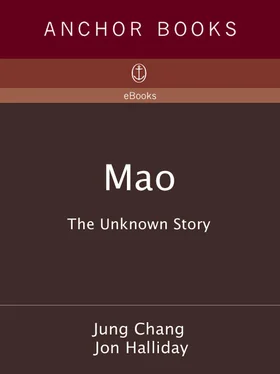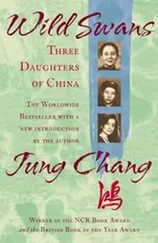They moved slowly due west, burdened by heavy loads. Arsenal machinery, printing machines and Mao’s treasure were carried on shoulder-poles by thousands of porters, most of them recently press-ganged conscripts, watched over by security men. The chief of the administrators revealed that the heaviest burdens were carried by people “who had just been released from the hard labour teams, and they were very weak physically … some just collapsed and died while walking.” Numerous marchers fell sick. One remembered:
The autumn rain went on and on, making our paths nothing but mud … and there was nowhere to escape the rain, and no good sleep to be had … some sick and weak fell asleep and never woke up. Many suffered infected feet, which had to be wrapped in rotten cloth and produced unbearable pain when stepping on the ground … As we left the base area further and further behind, some labourers deserted. The more obedient ones begged in tears to be let go …
The bolder ones simply dropped their loads and fled when their minders were distracted. Soldiers, too, deserted in droves, as the vigilance of their increasingly exhausted bosses wavered.
The marchers faced the daunting prospect of four lines of blockhouses — the same blockhouses that had doomed their Red base. Yet these turned out to be no obstacle at all — seemingly inexplicably.
The first line was manned by Cantonese troops, whose warlord chief had been doing profitable business with the Reds and had promised to let them through. Which he did. This combat-free breakout, however, was not due just to the anti-Chiang Cantonese. The Generalissimo was well aware that the Reds intended to pull out by way of the Cantonese front, and moreover he knew that they were going to be let through. On 3 October, shortly before the breakout began, he had told his prime minister that the Cantonese were going to “open up one side of the net” to the Reds. And yet Chiang explicitly rejected the idea of sending forces loyal to himself to the breakout sector. A close aide argued with him that to get Canton “to carry out orders, we have to have our men on the spot.” Chiang told him not to worry.
The marchers reached the second line of blockhouses at the beginning of November. Although the columns offered an easy target, extending over tens of kilometers, they were not attacked. The Cantonese again made no trouble. And neither did the other force defending part of this second line, which was under General Ho Chien, the fiercely anti-Communist Hunanese who had executed Mao’s ex-wife Kai-hui.
It was the same story at the third fortified line; yet Chiang not only did not reprimand Ho Chien for his apparent dereliction, on 12 November he promoted him to commander-in-chief of operations against the marchers. So it was this fierce anti-Communist who manned the fourth fortification line, situated at an ideal place to wipe out the Reds, on the west bank of the Xiang, the largest river in Hunan (which had inspired Mao’s poetry in his youth). There were no bridges, and the Reds, who had no anti-aircraft guns, had to wade across the wide river, easy targets from land and air. But again they went completely unmolested while they took four days to trudge across, spread along a stretch of river 30 km long. The commanding points on the banks were unmanned, and the troops under Ho Chien just looked on. Chiang’s planes circled overhead, but only to reconnoiter, and there was no aerial bombing or even strafing. Mao and the HQ forded the river undisturbed on 30 November, and by the next day, 1 December, the 40,000-strong main Red force was over.
Only now did Chiang, who had been monitoring the crossing “with total concentration,” his aides observed, seal off the river and order heavy bombing. Part of the Red rear guard was cut off on the east bank. The marchers who got across were down to half their original number, but included the main combat troops and the HQ. Chiang knew this. His commander Ho Chien wrote the following day: “The main force of the bandits have all [crossed the river], and are fleeing to the west.”
There can be no doubt that Chiang let the CCP leadership and the main force of the Red Army escape.
WHY SHOULD CHIANG have done this? Part of the reason soon emerged when, after the crossing of the Xiang, Chiang’s army drove the marchers farther westward towards the province of Guizhou, and then Sichuan. Chiang’s plan was to use the Red force for his own purposes. These two provinces, together with neighboring Yunnan, formed a vast southwestern region covering well over 1 million sq km, with a population of about 100 million; they were virtually independent of the central government, as they kept their own armies and paid little tax to Nanjing. Sichuan was particularly important, being the largest, richest and most populous, with some 50 million people. It was shielded on all sides by almost inaccessible mountains, which made access “more difficult than ascending to the blue sky,” in the words of the poet Li Po. Chiang envisaged it as “the base for national revival,” i.e., a safe rear for an eventual war against Japan.
Chiang could effect control only if he had his own army actually in the provinces, but they had rejected his army, and if he were to try to force his way in, there would be war. Chiang did not want to have to declare war openly on the warlords. His nation-building design was more Machiavellian — and cost-effective. He wanted to drive the Red Army into these hold-out provinces, so that their warlords would be so frightened of the Reds settling in their territory that they would allow Chiang’s army in to drive the Reds out. This way, Chiang figured, his army could march in and he could impose central government control. He wanted to preserve the main body of the Red Army so that it would still pose enough of a threat to the warlords.
Chiang spelled out his plan to his closest secretary: “Now when the Communist army go into Guizhou, we can follow in. It is better than us starting a war to conquer Guizhou. Sichuan and Yunnan will have to welcome us, to save themselves … From now on, if we play our cards right … we can create a unified country.” On 27 November, the very day the Reds started crossing the Xiang River and headed for Guizhou, Chiang issued his blueprint for nation-building, a “Declaration on the division of powers between the central government and the provinces.”
This agenda remained secret throughout Chiang’s life, and is still concealed by both Nationalist and Communist official histories. Both attribute the Communists’ escape to regional warlords, with Chiang blaming the warlords, and the Communists praising them. Both share the same concern: not to reveal that it was the Generalissimo himself who let the Reds go. For the Nationalists, Chiang’s methods for establishing his sway over the wayward provinces were too devious, and his miscalculation about using the Reds — which ultimately led to their triumph — too humiliating. For the Communists, it is embarrassing to acknowledge that the famed Long March was to a large extent steered by Chiang Kai-shek.
LETTING THE REDS go was also a goodwill gesture on Chiang’s part towards Russia. He needed a harmonious relationship with the Kremlin because he was under threat from Japan. And the CCP was Moscow’s baby.
But there was another, more secret and totally private reason. Chiang’s son Ching-kuo had been a hostage in Russia for nine years. Ching-kuo was Chiang Kai-shek’s sole blood descendant, not by the famous Mme Chiang, but by his first wife. After Ching-kuo was born, Chiang seems to have become sterile through contracting venereal disease several times, and he adopted another son, Weigo. But Ching-kuo, as the only blood heir, remained the closest to his heart. Chiang was steeped in Chinese tradition, in which the central concern was to have an heir. To fail to carry on the family line was regarded as the disgrace, the greatest hurt one could inflict on one’s parents and ancestors, whose dead souls could then never rest in peace. One of the worst curses in China was: “May you have no heir!” And respect for one’s parents and ancestors, filial piety, was the primary moral injunction dictated by tradition.
Читать дальше










